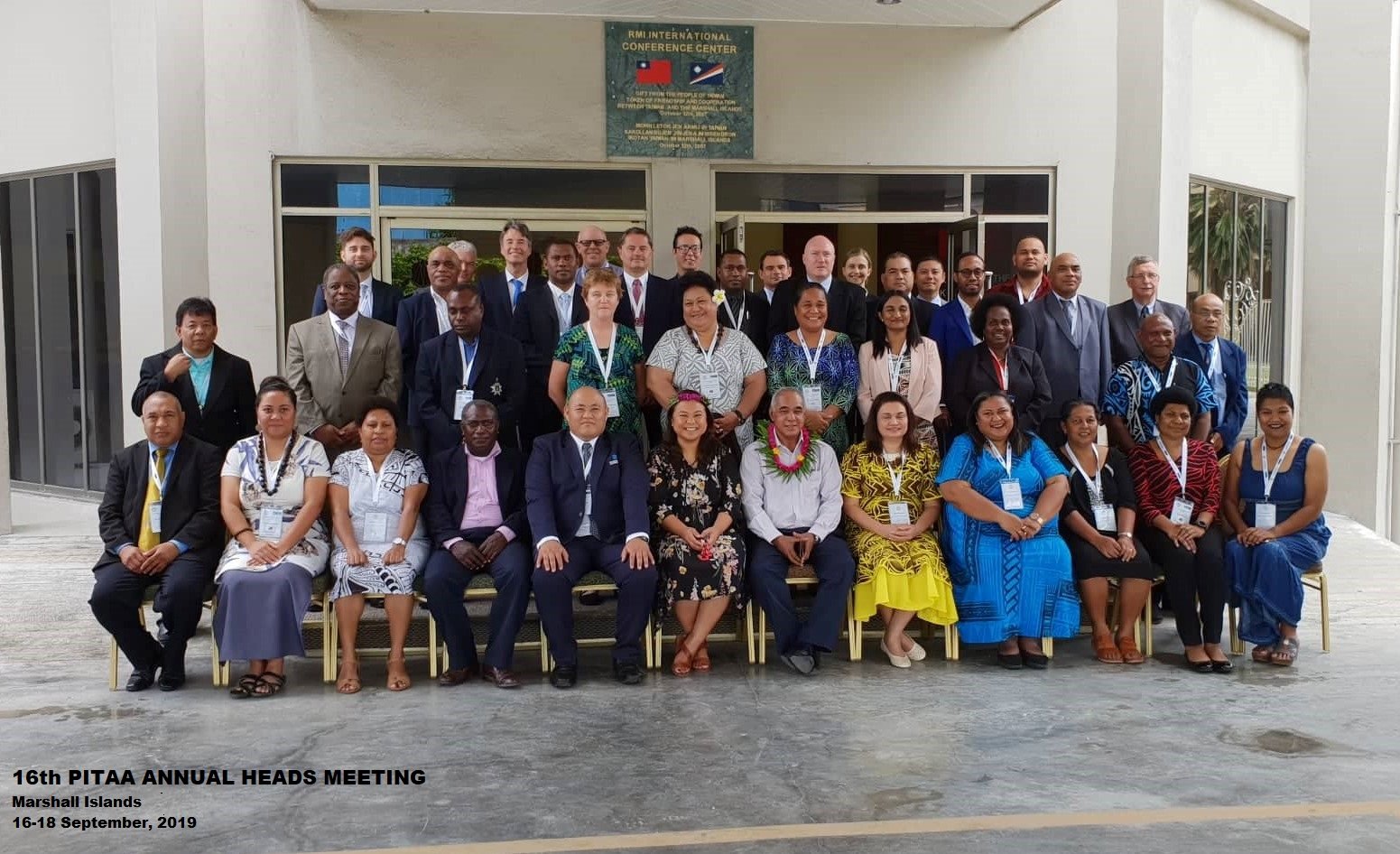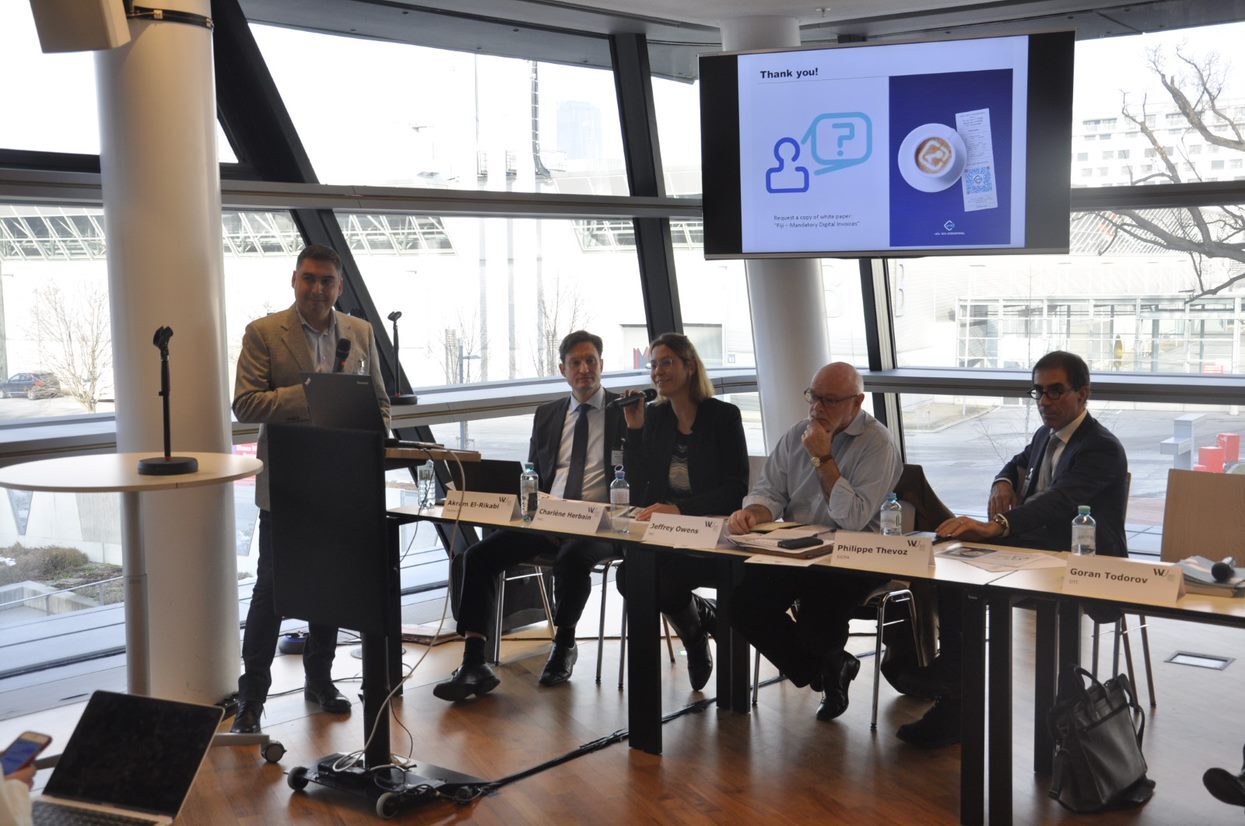Blog
Paying taxes is one of the fundamental principles of any country in the world, it is considered a duty...
One of the main reasons why TaxCore is such a good platform is the transparency it offers to tax authorities....
Only two months ago, it seemed as if the world economy was well recovering from the 2007 financial crisis....
The Samoan web-based monitoring tool T.I.M.S. (Tax Invoice Monitoring System) is currently in its production...
According to the official data from the European Commission, the EU lost approximately 137.5 billion...
After major success of TaxCore in Fiji, known as VAT Monitoring System (VMS) and the CATA presentation,...
16th Pacific Islands Tax Administrators Association (PITAA) Annual Heads Meeting
International Convention...
Grey economy appeared as a burning problem for many countries of the world ever since the creation of...
Data Tech International returned to the seminar for the second year in a row, but this time with new...
Recommended White Papers
List of publications:
Date Written: 13 May 2020
Abstract
Fiji, the largest of the Pacific Island Countries (PICs), is implementing a comprehensive digital invoice regime with the goal of the automatic, real-time and encrypted reporting of all taxable transactions, business-to-business (B2B), and business-to-consumer (B2C).
Fiji’s technology reform is intended to increase VAT compliance. It has attracted global attention because the technology reform has been undertaken along with a 40% reduction in the VAT rate, an expansion of the VAT base, and a prediction that VAT revenues would increase.
This paper considers the mechanisms Fiji has put in place to increase basic revenue flows. A second revenue stream, derived from applying the lessons learned in the current technology reform to cross-border trade in services and low-value goods, is forthcoming. The applications in that study will follow reforms in New Zealand and Australia (the so-called NetFlix and Amazon Taxes) and suggest that these efforts would be more successful if they were to be implemented in the same manner that Fiji has approached its current technology reform.
From a high level, Fiji envisions a business-government digital partnership producing “… an electronic system [designed to] transmit[s], receive[s], record[s], analyze[s], format[s], store[s], and monitor[s] fiscal data.” The partnership is comprised of (a) the “Authority’s system,” the TaxCore, and (b) the mandatory electronic fiscal device (EFD), that is, the system “… used by taxpayers in operating their business,” The strength (and the uniqueness) of the Fiji VAT is in its real-time data collection, its data protection, and its data retention capabilities. When fully implemented these technological reforms promise to capture lost revenues in Fiji of at least FJ$185 million. The amount could be much higher, but it is unlikely to be lower.
There are exceptional efficiencies in tFiji’s comprehensive digital invoice regime. Fiji will be the first VAT jurisdiction in the South Pacific, and one of the few globally to secure real-time, encrypted reporting of all taxable transactions, business-to-business (B2B), and business-to-consumer (B2C). Many of the traditional VAT frauds are simply unworkable in this system. Enforcement flows directly from the technology.
A considerable amount of the auditing function in Fiji will be automated through proof of audit concept. Its use of digital counters is unique, as well as the use of E-SDCs and V-SDCs around the TaxCore. Fiji is the classic example (in the tax world) of where the Code (meaning the computer code) is the law.
Authors: Richard Thompson Ainsworth & Goran Todorov
Date Written: 06 Nov 2023
Abstract
To improve the management of tax compliance risks, tax administrations are increasingly seeking opportunities to enhance their access and use of data. For many years, there has been a worldwide trend to implement electronic fiscal reporting (also known as fiscalization) to achieve these aims. Fiscalization refers to the process of automated reporting of a taxpayer’s business activities to the tax administration. When implemented as an integral part of compliance risk management processes, fiscalization will contribute to an improvement in tax compliance by making it easier for taxpayers to voluntarily comply, and discouraging taxpayers who may choose to not report their business transactions. However, fiscalization alone will not address all tax compliance risks. This how-to note provides practical guidance about the case for fiscalization and implementation approaches, including good practices and practices to avoid in relation to the key dimensions of fiscalization: data collection, data analysis, integration with compliance risk management, consumer engagement, and implementation.
Authors: José Maria Pires, Stephen Howlin, and Mr. Frank van Brunschot
Date Written: 16 May 2020
Abstract
Over the past decade the VAT in the South Pacific has been changing. More change is coming. Change is needed in both the larger economies (Australia and New Zealand) and the smaller ones (the Pacific Island Countries or PICs). The changes we see currently are propelled by cross-border remote sales of services and low-value goods.
The government response in the South Pacific is not uniform. The larger economies have relied on statutory remedies; the smaller economies are turning to technology. The larger economies are crafting complex, extra-territorial compliance provisions targeting remote sellers. The smaller economies are mandating secure digital invoices, real-time reporting, with mechanisms for proof of audit, that is setting the stage for a B2C reverse charge mechanism, and later adoption of a block-chain-based information exchange.
Press attention is being drawn to the larger economies through catchy newspaper headlines. There is the “Netflix Tax” (for rules directed at cross-border supplies of services) and the “Amazon Tax” (for rules directed at cross-border supplies of low-value goods).
Technologists are approaching remote sellers differently than are statutory draftsmen. In a residential VAT a technologist will focus on improving domestic (residential) compliance. No new extra-territorial tax (requiring non-residents to help collect and remit it) is added. Instead, there is simply a push for more granular data and an effort to capture each taxable transaction in real-time. Technologists are digitally preserving the supply chain. Each step is recorded so that the receipt of cross-border services, or the purchase of even the smallest-valued goods can be minutely identified and subjected to tax under existing rules.
An additional level of enforcement may be needed. It too will be technology-based, and should borrow from the Brazilian prioritizing of digital over paper records known as SPED (Sistema Publico de Escrituracao Digital or the Public System for Digital Accounting). SPED, or something similar, is undoubtedly part of the trajectory of Fiji’s digital reform. It should be part of New Zealand’s “Netflix Tax.”
Considered narrowly, this series of four papers is a specific proposal that New Zealand’s “Netflix Tax” should be reconfigured and strengthened with the technological vision that is embedded in Fiji’s VAT reform.
Considered more broadly, this is a multi-part comparative study of the way a “Netflix Tax” should be adopted. It starts with New Zealand’s reform, a statutory fix to the current problem, and then considers how New Zealand could benefit from Fiji’s technology. It suggests that if Fiji’s technological fix to the remote services problem had been considered by New Zealand, then the “Netflix Tax” would be simpler to administer, and the remote services transactions would be far easier to audit.
But this collection of four papers goes further. They also indicate that New Zealand, or any jurisdiction that follows this path, should very quickly be able to craft a digital B2C reverse charge mechanism. The potential to do so is inherent in the full development of Fiji’s technology. In addition, such a jurisdiction should be ready to migrate to a multi-jurisdictional block-chain where a real-time information exchange is possible. Such a block-chain is the next very necessary step in modern cross-border VAT administration.
Author: Richard Thompson Ainsworth
Date Written: 16 May 2020
Abstract
This is the second in a four-part series addressing VAT/GST avoidance schemes involving remote sales of services. These schemes have been growing in importance. The IMF reports that the services component of cross-border trade has been on the rise for fifty-years or more, making the Internet a serious threat to revenue. Technology has accelerated tax avoidance.
Statutory draftsmen in New Zealand have looked at this problem directly with what has been called the Netflix Tax. Technologist in Fiji have been struggling with similar problems and have developed technology-based security systems that would seem to address remote sales of services more effectively than traditional approaches. Fighting technology with technology has some distinct advantages over a traditional statute and regulation approach. In a very real sense, computer code can be law, and can function as a tax regulation.
Three additional aspects of the New Zealand Netflix Tax will be considered in this part:
(a) threshold rules;
(b) remote enforcement; and
(c) double taxation of remote services. In each case the New Zealand rules will be considered, followed by an overlay of Fiji’s technological solution to show how inherent problems with traditional statutory solutions adopted by New Zealand can be mitigated with technology.
The two papers following this part will consider four remaining issues:
(a) placing tax responsibility for reporting and collecting VAT/GST with an electronic marketplace;
(b) how to deal with domestic agents of remote service providers;
(c) how to detect and respond to false information sent to the tax administration; and
(d) how to deal with dual-status taxpayers.
Author: Richard Thompson Ainsworth
Date Written: 16 May 2020
Abstract
This is the third paper examining the recent amendments to the New Zealand Goods and Services Tax (GST) that are commonly known as the Netflix Tax. A fourth paper will follow.
The importance and complexity of dealing with electronic marketplaces has made an independent paper on electronic marketplaces necessary. Taken together this set of four papers assess the effectiveness of the Netflix provisions, and how they can be enhanced by adopting the technology and vision of Fiji’s VAT Monitoring System (VMS). The Netflix provisions were effective, July 1, 2017.
This paper considers rules that allocate the responsibility for collecting, reporting and remitting GST between:
(a) the digital platforms in one instance, and
(b) the remote (third-party) service providers that use digital intermediaries to sell into New Zealand in the other instance.
The fourth paper will consider the three remaining issues:
(a) the treatment of domestic agents when they are used by remote service providers to facilitate sales to New Zealand customers;
(b) how New Zealand responds to resident consumers who supply false information to remote service providers so that the service provider will zero-rate a transaction, thereby defeating the GST; and
(c) the treatment of dual status taxpayers, New Zealand residents whose status allows them to enter into contracts with remote service providers either as individual consumers or as business taxpayers.
As before, the primary contrast is the difference between New Zealand’s traditional (statute and regulation) approach to VAT reform, and the technology-intensive approach of Fiji. Both jurisdictions are struggling to deal with the modern economy, but they approach this challenge very differently. These papers come down on the side of Fiji and technology. In the end it observes that what Fiji understands is that code, computer code, is very effective and cost-efficient regulation. There is something important to learn about the way that Fiji utilizes “code” (computer code) in its tax reform.
Date Written: 16 May 2020
Abstract
This is the fourth paper examining the recent amendments to the New Zealand Goods and Services Tax (GST); amendments that are collectively known as the Netflix Tax. These papers assess the effectiveness of the Netflix provisions, and how they could be enhanced if New Zealand adopted the technology and vision of Fiji’s VAT Monitoring System (VMS). The Netflix provisions were effective, July 1, 2017.
This final paper considers:
(a) the treatment of domestic agents when they are used by remote service providers to facilitate sales to New Zealand customers;
(b) how New Zealand intends to respond to resident consumers who supply false information to remote service providers in an effort to induce those providers into improperly zero-rate transactions, and thereby defeat the GST; and
(c) the treatment of dual status taxpayers, New Zealand residents whose status allows them to enter into contracts with remote service providers either as individual consumers or as business taxpayers.
As before, the primary contrast is the difference between New Zealand’s traditional (statute and regulation) approach to VAT reform, and the technology-intensive approach of Fiji. Both jurisdictions are struggling to deal with the modern economy, but they approach this challenge very differently. These papers come down on the side of Fiji and technology. In the end they observe that what Fiji understands is that code, computer code, is a very effective, cost-efficient, and self-enforcing form of regulation. There is something important to learn about the way that Fiji utilizes “code” in its tax reform.
New Zealand’s residence-based GST has visible difficulties trying to regulate the remote services market with the standard approaches to tax reform. New Zealand works well with the data that it has from residential sources, but it simply does not have what it needs to do the job when the supplies are remote. It needs data in real-time, because the consumption is happening in real-time. In some instances, New Zealand has drafted reasonably complex rules to secure more information. But it is clear that something more, something different, something slightly more radical, and very real-time is needed to come to grips with managing compliance in this field.
Author: Richard Thompson Ainsworth
Date Written: 2020
Abstract
What do the prevention of malaria, the efficiency of the financial markets, access to clean water, a reliable judicial system, safety in the streets or the maintenance of the transportation infrastructures in a country have in common? Apart from the fact that they may all be considered desirable objectives; all require financing and significant collective action. When facing these challenges, external international aid may contribute to initiate the processes or to face critical situations of extreme need. Nevertheless, because of medium- and long-term sustainable development, it is essential for each country to count on its own resources and management capacity. And here is where the tax administrations (TA) play their role. As highlighted by all the experts in institutionalism and the origin of the modern states, such as, for example, Francis Fukuyama in his work entitled “The Origins of Political Order”, the capacity for collecting taxes along with the rule of law, is one of the pillars of collective action. The objectives of said collective action may vary, as well as the levels of expenditures to be financed, but in any case, an efficient tax administration will be required for obtaining the necessary resources.
Date Written: 2019
Abstract
Throughout the world, digital technologies are significantly impacting economies, businesses and society and creating new products, services and business models. While digital transformation can create new challenges for tax administrations, it also makes new tools available to improve tax compliance, reduce administrative burdens on taxpayers and help to support growth. The success of modern tax administrations is increasingly becoming dependent on access to data flows, including in real-time. This will only increase with the development of “the internet of things”, a network of connected devices and sensors constantly measuring and transmitting real-time data about the behaviour of the surrounding environment. One of the most important data flows for tax compliance purposes is information on retail income. It is also one of the most important economic indicators, characterising consumer confidence as well as the health of economy. Cash registers provide the key source of original data in the retail sector for tax auditors. In their efforts to address unreported sales and the hiding of income, tax administrations have made many attempts to ensure timely and uncompromised access to this source of information. Advances in digital technology have opened new opportunities for the enforcement of closer controls over retail transactions and reducing tax risks that were traditionally associated with the vulnerability of cash register data.
Author: Mikhail Mishustin
Date Written: May 2017
Abstract
Electronic Billing Machines (EBMs) enable revenue authorities to monitor formal business transactions and thus offer the potential to improve VAT compliance. However, because firms can choose not to issue receipts or issue false receipts, EBMs do not offer truly objective tax reporting and have thus offered limited benefits to tax collection. Using examples from Rwanda, this paper argues EBMs can have transformative impacts for VAT compliance, but only when combined with data analytics and receipt audits to enforce EBM receipt issuance. This can be done using a three-step approach: initial ‘benchmark audits’ can establish firms’ true sales patterns; data analytics then flag firms deviating from this pattern, which trigger automatic ‘mystery shopper’ audits to verify non-compliance and sanction the firm. EBMs combined with these measures offer a powerful way to ensure firms accurately report on VAT liabilities, which may significantly improve domestic revenue mobilisation in countries with high VAT non-compliance.
Author: Victor Steenbergen
Date Written: August 22, 2013
Abstract
A digital invoice customs exchange (DICE) is a technology-intensive tax compliance regimen for VAT/GST that utilizes invoice encryption to safeguard transactional data exchanged between seller and buyer in both domestic and import/export contexts while simultaneously notifying concerned jurisdictions of the transaction details.
DICE facilitates real-time VAT/GST enforcement as well as real-time commercial contract verification. It is a commercial invoice validation system that prevents tax evasion, most notably missing trader fraud and the non-declared import of trade-able services. DICE mimics the most effective administrative enforcement effort ever undertaken by the US IRS – the requirement to disclose the social security numbers of dependents on returns. Tax enforcement is simplified and streamlined when fraudsters know they are (or they are convinced that they could be) being watched – in real-time detail.
DICE is an emerging compliance solution that has been adopted in part by some jurisdictions, but (as of this writing) has not been adopted in full by any jurisdiction.
There are two elements to DICE – the digital invoice and the customs exchange. This paper presents both elements and indicates where early successes have been recorded in implementation.
Authors: Richard Thompson Ainsworth & Goran Todorov
Date Written: August 15, 2013
Abstract
The value added taxes (VATs) of the East African Community (EAC) are open to manipulation and are leaking revenue from tradable services transactions. The EAC’s response has been to adopt a unique Reverse VAT mechanism. Something more is needed – a Digital Invoice Customs Exchange. Together these adjustments will provide a world-class solution to a world-wide problem. The EAC appears to be moving in this direction.
The vulnerability of the EAC VATs to tradable services is not surprising. The EAC borrowed VAT designs from the major VAT models, the EU VAT and the New Zealand Goods and Services Tax (NZ GST). Both of these models have the same flaw.
The flaw is structural. Both the EU VAT and the NZ GST classify supplies in two groups, goods and services, when in fact there are three classes. Each member of the EAC adopts the same classification.
The main question addressed in this paper is: Is it possible to construct a digital customs clearance regime a digital invoice based system that would advance to a customs exchange (Digital Invoice Customs Exchange, or DICE)? Could a secure, searchable, real-time digital record be kept of all imported tradable services? The EAC is close to doing this today.
This paper will show how fraudsters use tradable services to steal VAT receipts intended for the government. It will explain how the Reverse VAT (common in residence-based VAT/GST systems) attempts to block this fraud, and then demonstrates how data security measures (digital invoices) when coupled with a real-time remote audits (made possible with customs exchanges) will identify and largely eliminate B2B frauds in cross-border trades and most importantly tradable services.
It may not be common for the EAC to find itself at the forefront of global tax policy/tax design, but this is where it finds itself today. Neither the EU nor NZ are ready for the solution that the EAC can implement now. The EAC can demonstrate the elegance of an advanced technological solution to a global VAT problem. It should do so.
Date Written: May 3, 2013
Abstract
A Third Invoicing Directive for the EU VAT seems to be a foregone conclusion. Corrections are needed in the Second Invoicing Directive. The hallmark of the next Directive will be its application of digital invoice technology. The Commission’s proposals will include adoption of tax-technology advances in invoice-control that are currently in use outside the EU. The next Invoicing Directive will require comprehensive e-invoicing, invoices that are digitally signed, and invoices that are fed into a system of relational databases that match transaction data across the Single Market. There will be real-time EU sales/purchases lists, and remote/real-time audit functionality.
This will occur, because the true target of the Third Invoicing Directive will be missing trader intra-community (MTIC) fraud, not invoices. Improvements in invoicing will be a means to achieve a larger end.
This will not be a “black swan” IT effort. The needed technology is here today; the necessary systems are tried and proven in large multi-jurisdictional tax systems; the implementation costs will be a small fraction of the €100 billion that is currently lost to MTIC fraud annually.
This paper “connects the dots.” It considers Brazil’s successful digital invoicing regime in the Sistema Publico de Escrituracao Digital or Public System for Digital Accounting (SPED) and applies what has been learned to the pattern of MTIC and missing trader extra-community (MTEC) frauds in the EU. A follow-up paper will align the Croatian Fiskalizacija – IT (Fiscalization program) with the Brazilian SPED, and then consider the data security and remote audit functionality of the newly implemented Rwandan system.
There is much to be learned and borrowed from these systems. Workability is assured.
Date Written: February 26, 2010
Abstract
Zappers skim cash sales at retail. Zappers are add-on programs used by merchants with electronic cash registers (ECRs) or point-of-sale (POS) systems. Zappers are smart and selective. They do not skim all sales, and they never skim credit card transactions.
Although they are present in every jurisdiction, Zappers appear to be most widely used in developed economies that combine high levels of cash sales with high rates of consumption tax. Sweden, for example, has a cash-intensive economy, one of the world’s highest VAT rates (25%), and also reports that 70% of the ECRs in the country are either “… constructed for manipulation or have had software installed that allow sales to be manipulated (Zappers)…”
Tax losses in the EU can be estimated at approximately $23 billion per year in the restaurant sector alone. Germany tops the list followed by the UK, France, Italy and then Spain.
This is not the only marketplace where the tax/technology intersection is problematical. On a far larger scale MTIC (missing trader intra-community) fraud is also a technology driven theft of public revenue by criminals. These frauds include the well known carousel frauds in cell phones and computer chips, MTIC fraud in CO2 permits, the yet to be fully investigated VoIP MTIC, as well as MTIC in the electricity and gas exchanges.
Tax authorities are fighting back all along the technology front. There are intensive traditional audits as well as concerted efforts to blunt the effectiveness of the fraud with technology. But, if there is one distinguishing characteristic of Zapper enforcement efforts it is that here the authorities are embracing technology-based solutions. This effort to fight technology-with-technology has produced a measure of success as well as helped develop strategic partnerships around solutions. Cooperation is evident.
Date Written: May 11, 2009
Abstract
The Sales and Use Tax is an essential part of Puerto Rico’s revenue profile. Effective only recently (November 15, 2006) the Impuesto a las Ventas y Uso (IVU) was expected to raise between $2.3 and $1.05 billion annually, and has already become the Commonwealth’s fourth largest revenue source. Actual revenue results for 2007-2008 came in at $1.1 billion, which admittedly is closer to the low end than the high end of what is possible, but now that the tax is in place the next pressing question is how can its performance be improved?
This paper generally proposes that Puerto Rico look to technology for improvements. It suggests that Puerto Rico consider adopting one or more of the software certification efforts underway globally to boost revenue results. The specific focus of this paper is on stopping cash skimming frauds (the use of Zappers), but it is important to see this as part of a wider movement to utilize certified technology to improve compliance and enhance revenue.
Two IVU issues should be at the top Puerto Rico’s tax policy agenda: (1) should the Commonwealth adopt the Streamlined Sales and Use Tax Agreement (SSUTA) and (2) how can Puerto Rico stem revenue losses from automated sales suppression software (Zappers). The first initiative would yield additional revenue of $200 million; the second effort would likely yield an additional $170 million.
Because joining the SSUTA is as much a political as it is a tax question, this paper has focused on preventing automated sales suppression as a way of enhancing revenue. This is a global problem that will only grow in significance. It is difficult to believe that the Zappers that are rampant throughout the world and not also very common in Puerto Rico. It seems that wherever ECRs are used to record sales, Zappers have been found removing cash sales and allowing businesses to siphon off revenue.
With Puerto Rican revenue losses possibly in the hundreds of millions of dollars this paper has made an effort to point to cost-effective remedies within the Streamlined Sales Tax, notably, the certified service provider (CSP) option. Puerto Rico has not become a full member of SSUTA, but that does not prevent it from taking an arrow from the SSUTA’s quiver and directing it at the Zapper.
Zappers are a documented problem in Quebec, Germany, the Netherlands, Australia, Brazil, Sweden, Austria, France, the UK and the US. This is the reason that representatives of the German, Quebec and Dutch revenue authorities will be sharing both their technology solutions and their auditing techniques with other government officials at the Federation of Tax Administrators Annual Conference in Denver Colorado, June 2, 2009.
Author: Richard Thompson Ainsworth
Date Written: 8 Jan 2009
Abstract
California has not uncovered a single instance of technology-assisted cash skimming – there are no zappers, and no phantomware in California. Is this because Californians are not skimming cash sales with technology, or is this because the California technology works so well that the fraud cannot be detected?
The record in foreign jurisdictions is reasonable clear. Automated sales suppression technology is widely used to skim cash sales, denying the state revenues from consumption taxes that have been paid by the consumer, reducing taxable business profits, and funding a cash hoard out of which unreported employee wages are paid. Government studies indicate that upwards of 50% of the electronic cash registers (ECRs) are infected with fraud-facilitating software.
This paper recommends that the California Commission on the 21st Century Economy look carefully at this digital tax fraud. There are new ways of performing old frauds. The new ways have made familiar frauds difficult to detect without the assistance of technology-sensitive legislation (and regulation) as well as technology-intensive audit tools. In short, California needs to determine if a digital hole has been cut through the bottom of the modern ECR through which revenue is being poured. Foreign revenue authorities are making efforts to plug this hole, as of yet California has not done so.
Specifically, this proposal asks the Commission to recommend that a randomized, statistically valid study be taken of automated sales suppression within the State. The study should consider add-on software (zappers), factory or distributor installed software (phantomware), and manually re-programmed ECRs (self-help phantomware). The Commission should further recommend that if the results of this study align with the results of similar (foreign) studies then appropriate legislative (or regulatory) changes should be enacted to meet this challenge. A technology-intensive audit response will most likely (but not necessarily) also be required. This paper summarizes four of these approaches.
Admittedly, one of the reasons this problem has not been better addressed is that almost all of the work in this area is being done in foreign languages – French, German, Portuguese, Dutch and Swedish. However, California might consider reading some foreign newspapers and begin to ask questions when a business with California operations is found to be using zappers to skim cash sales in a foreign jurisdiction. Zappers follow the path cut by the ECRs. They do not respect judicial boundaries. For example, when Celine Dion’s Nickel restaurant chain was raided by Revenue Quebec, and each of the 32 Nickel restaurants in the Province were found using zappers, the zapper question should have arisen in the mind of the Florida Department of Revenue where there were 2 more Nickel restaurants. It certainly did in the mind of the Ontario authorities where the remaining 10 Nickel restaurants were located.
Author: Richard Thompson Ainsworth
Date Written: 28 Oct 2008
Abstract
Although there is no public acknowledgement – in the press, in a court case, though any announcement by the Japanese National Tax Administration, or in any academic studies or papers – that Zappers and Phantom-ware are a fraud problem in Japan, a number of factors suggest that Japan may be very fertile ground for technology-assisted cash skimming fraud. Those factors include: (1) a high concentration of small to medium sized businesses; (2) the fact that the retail economy is highly cash-based; and (3) the high level of technology acceptance in the Japanese retail sector – electronic cash registers (ECRs) and point of sale (POS) networks are commonly employed in the retail trade.
It is something of an anomaly that this kind of fraud appears to be a very serious and well documented in wide range of developed countries (Canada, the Netherlands, Germany, Brazil, Australia and Sweden) but it does not appear to be visible in the two largest developed economies Japan and the United States. The US has two cases; Japan has reported none.
Although it may be possible that Zappers and Phantom-ware are not in use in the US and Japan, it seems more likely that they are being used (perhaps widely) but that insufficient (or technologically limited) audit resources are committed to computer fraud detection in the small and medium sized business sector. Detecting Zapper and Phantom-ware fraud requires auditors to break down and analyze the programming of modern ECRs and POS systems.
There are three major sections to this paper. The first section outlines the historical development of Zappers and Phantom-ware. The second measures the significance of this fraud. Two measures are used direct and indirect. The direct uses the few (empirical) studies that governments have made public on this problem. The indirect measure considers the case law which shows that large amounts of cash have been diverted by these programs, and that once established in a marketplace large numbers of businesses follow one another in adopting this technology. The final section considers government responses.
The paper concludes, that if the Japanese National Tax Administration perceives Phantom-ware and Zappers to be a serious threat to revenue, and if Japan would like to consider a rules-based (fiscal memory) solution as opposed to a principles-based (comprehensive traditional audits supplemented with enhanced training in technology) solution, then the Greek, Quebec and German approaches to this problem need to be looked at carefully. This is an approach that fights technology with technology.
Author: Richard Thompson Ainsworth








